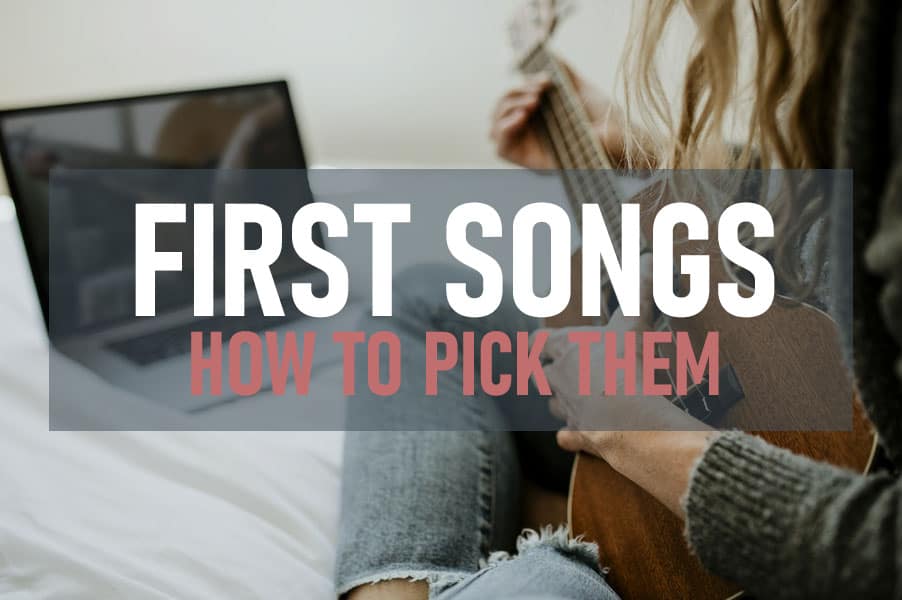When learning to play the ukulele or any instrument for that matter, there is a big difference between easy songs and first songs.
When I first tried to pick up the ukulele, I brought Grant (the most experienced player here at Uke Planet) a list of songs that I thought would be good first songs. They seemed perfect as they were on all of the “super easy” song lists I could find online.
However, with most songs on those “easy” lists, they’re only there because the chords are simple to learn. But that doesn’t necessarily mean the song is easy to play. For complete beginners, many popular songs will be a bit too challenging to strum and sing along with at the same time. This is especially true for vocally-driven pop songs.
Those lists come in quite handy when you’re ready to progress after a month or two of practice, but not day one.
The real place to grab your first song is from your childhood.
Nursery rhymes and children’s songs are perfect for beginners because they tend to be lyrically and rhythmically straight forward. By that, I mean that strumming, singing, and chord changes will follow closely with each other. Additionally, the tunes are often etched in our memories which adds familiarity when everything else will be new.
We have a few song suggestions for you at the end of this post, but let’s just first explain a bit of what we’re talking about so you’ll be armed with what you need to choose your own beginner tunes as you go along.
Choose Songs With the Easiest Chords
There are a handful of chords that we think you can realistically learn on your first day of practice, and grow very comfortable with over the course of a couple of weeks.
After a month of consistent daily playing, you’ll be able to flow in and out of each of these positions with ease. They are used in a wide range of popular radio songs and nursery rhymes alike.
They are the C, C7, Am, F, G, and G7.

I’ve arranged the most commonly used chords on the top row, and the bottom row shows the commonly used variations of the C and the G chords, the C7 and G7.
If you’re new to chord charts like this, just know that the orange circles represent a finger position, and the numbers represent a finger. Your pointer finger is 1, your middle finger is 2, your ring finger is 3, and your pinky finger is 4.
For the open black circles, they represent open strings, or rather strings that you strum without placing a finger on them. If instead there was an X in place of the open circle that would mean that the string should not be strummed with the others.
The vertical lines represent strings while the horizontal lines represent frets. The thick horizontal line represents the nut (very top of the fretboard).
Choose Songs That are Straight Forward
By straight forward I’m referring to songs that have chords and lyrics that have little variance from one verse to the next. Additionally, the lyrics and the chord progressions follow each other as well as the rhythm closely. This is why nursery rhymes or children’s songs are great starting pieces. They are designed to be chanted without music. That means that the lyrics will often help us stay on beat, and at times even drive the rhythm of the song for us.
But, don’t confuse that with music that is vocally driven. A lot of modern pop music seems simple and straight forward at first, but in reality it is crafted to give the vocalist room to get creative. The chords are often very easy, but the lyrics and chords often do not progress in a straight forward manner. In other words, as a beginner, it will feel like you’re trying to write your first name with your left hand and your last name with your right hand at the same time. That is incredibly hard to do! Give it a try if you must. 🙂
Compare that to writing your first name with your right and left hands at the same time. Much easier. The more each piece of a song stays in sync, the easier it will be for a beginner.
Choose a Song That You Know the Tune to
It is key to point out that I don’t mean a song you can sing along with while it is playing in the background. I mean a song that you can sing from start to finish without music.
The goal of your first song is to be overly familiar with it so that all of the new stuff (chords, strumming patterns, etc) will not overwhelm your mental focus.
Additionally, a short song is a fairly good starting point as well. This is a good idea because it lets you repeat the same elements over and over again without little breaks in between.
It will allow you to easily remember which chords you use and where. This lets you focus on looking at your finger positions rather than needing to bounce back and forth between your music sheet and fingers early in the process.
As you progress, using sheet music is a must, but when you’re learning chords it’s important to look at your finger positions for accuracy. As a beginner having choppy song play can be frustrating, and glancing back and forth is a major part of that lag.
My Three Favorite First Songs
Marry Had a Little Lamb

Eensy Weensy Spider

This Little Light of Mine


